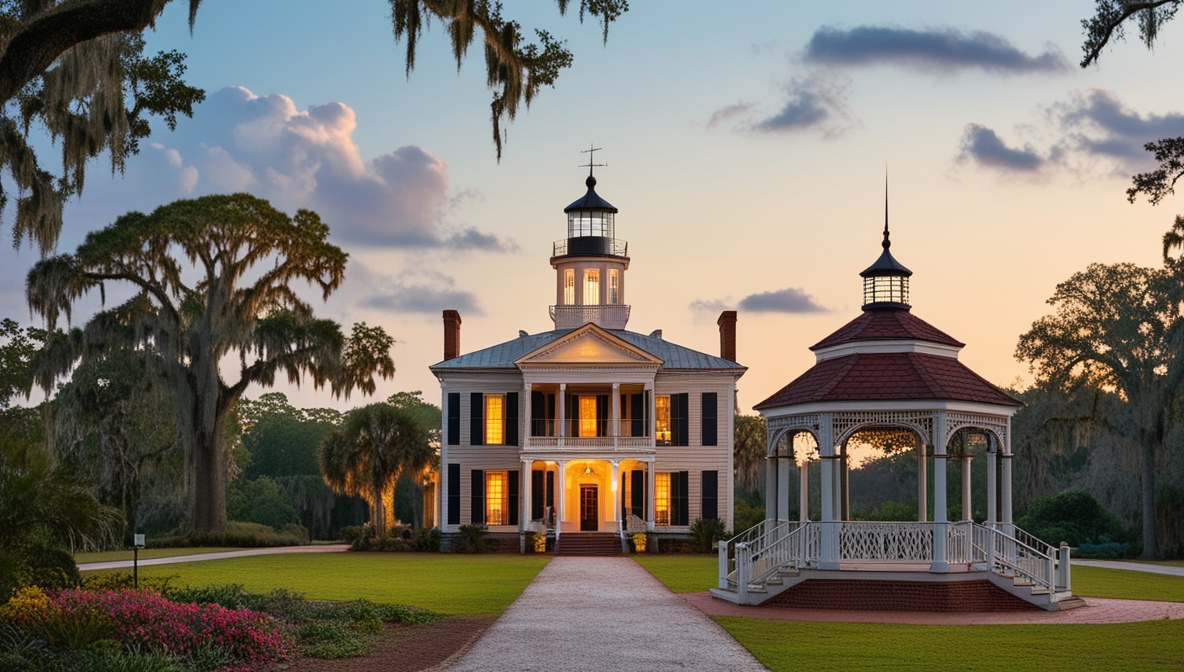
The Lowcountry of South Carolina and Georgia is a region rich with history, culture, and breathtaking landscapes. From antebellum plantations to key sites of the Civil War, this area offers a fascinating glimpse into America’s past. Below, we’ll explore some of the most famous historic landmarks in the Lowcountry that you should know.
Fort Sumter: The Start of the Civil War
The First Shots of the Civil War
Fort Sumter is a key site to understanding the Civil War impact on Lowcountry. It was here, in April 1861, that the first shots of the Civil War were fired, marking the beginning of the four-year conflict.
Touring Fort Sumter Today
Visitors can take a ferry from Charleston to explore the historic fort, view original cannons, and learn about its strategic importance during the Civil War through museum exhibits and guided tours.
Middleton Place: A Historic Plantation
The Oldest Landscaped Gardens in America
Middleton Place, located along the Ashley River, is a former rice plantation known for its beautiful formal gardens, which are considered the oldest in America. The symmetrical layout, reflecting pools, and centuries-old camellias make it a must-visit site for history and garden enthusiasts.
A Glimpse into Plantation Life
The plantation house museum offers a look at life during the 18th and 19th centuries, showcasing original furnishings, artwork, and artifacts from the Middleton family, one of South Carolina’s prominent colonial families.
The Old Slave Mart Museum
Charleston’s Dark History
Located in Charleston, the Old Slave Mart Museum is one of the few remaining sites in the United States where enslaved Africans were sold. This museum presents the harrowing history of the transatlantic slave trade and the impact of slavery on the South, revealing much of the hidden history of Lowcountry that shaped the region’s identity.
Exhibits and Educational Resources
The museum provides exhibits and resources that detail the lives of the enslaved people, the slave markets, and the legacy of slavery in shaping the region’s history and economy.
The Beaufort National Historic District
A Well-Preserved Southern Town
Beaufort, South Carolina, is one of the South’s best-preserved historic towns, and its National Historic District is a testament to its enduring charm. The district is filled with antebellum mansions, quaint streets, and Spanish moss-draped oaks.
Key Historical Sites in Beaufort
Visitors can explore notable landmarks such as the John Mark Verdier House, which offers insight into the area’s past, or take a walking tour through streets that have witnessed pivotal moments of Southern history.
Drayton Hall: A Preservation of Antebellum Architecture
A National Historic Landmark
Drayton Hall, located along the Ashley River, is the oldest preserved plantation house in the United States still in its original condition. Built in 1738, this Georgian-Palladian home survived both the Revolutionary War and the Civil War. Drayton Hall offers a rare glimpse into 18th-century plantation life and stands as a prime example of historic architecture preserved in its original state.
The Drayton Legacy
With no modern conveniences added, Drayton Hall offers a rare glimpse into 18th-century plantation architecture. The site also highlights the lives of the enslaved workers who were integral to its operations.
The Penn Center: A Pillar of African American History
One of the First Schools for Freed Slaves
The Penn Center, located on St. Helena Island, South Carolina, is one of the first schools in the South established for formerly enslaved African Americans. Founded in 1862, it became a vital institution during the Reconstruction era and beyond. Today, it continues to preserve the Gullah culture in Lowcountry and African American history through its museum and educational programs.
Civil Rights and Cultural Preservation
The Penn Center played a crucial role during the Civil Rights Movement, serving as a retreat and meeting place for leaders like Dr. Martin Luther King Jr. Today, it continues to preserve the Gullah culture and African American history in the Lowcountry through its museum and educational programs.
The Battery and White Point Garden
A Symbol of Charleston’s History
The Battery is a defensive seawall and promenade in Charleston, lined with stately antebellum homes and historical monuments. At the tip of the Battery is White Point Garden, a public park that features cannons and memorials from the Civil War.
Views of Fort Sumter and Historic Mansions
This iconic Charleston location offers stunning views of Fort Sumter across the harbor, and visitors can stroll through streets lined with historic homes, many of which played significant roles in the city’s history.
Magnolia Cemetery: Resting Place of Confederate Soldiers
A Historic Burial Ground
Magnolia Cemetery in Charleston is the final resting place of thousands of Confederate soldiers, including those from the crew of the CSS Hunley, the first submarine to sink an enemy ship. Established in 1850, it remains a poignant reminder of the Civil War’s toll on the South.
Gothic Architecture and Scenic Views
The cemetery is known for its gothic-style architecture and beautiful setting along the Cooper River, making it a site of both historical significance and serene beauty.
Conclusion: Exploring the Lowcountry’s Rich History
The Lowcountry is home to some of the most important historic landmarks in the United States. From the battlefields of the Civil War to the plantations that shaped the economy and society, visiting these sites offers an opportunity to connect with the past and understand the cultural heritage of this unique region.